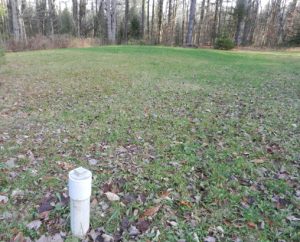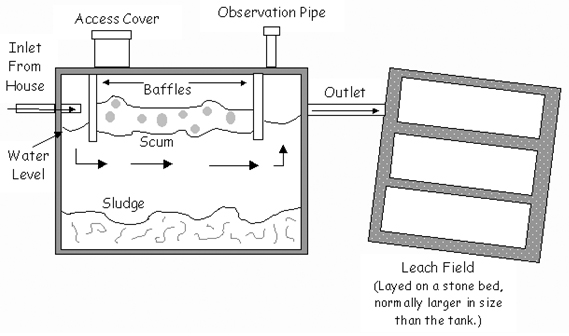Bulletin #7080, Your Septic System
Reviewed and updated by John M. Jemison, Jr., Extension water quality and soil specialist
For information about UMaine Extension programs and resources, visit extension.umaine.edu.
Find more of our publications and books at extension.umaine.edu/publications/.
Table of Contents
- Why Maintain Your Septic System?
- Pumping Out Your Septic Tank
- Finding Your Septic System
- Evaluate Your Septic Practices
- How Your System Works
- Maintenance Record
 If you are a suburban or rural resident, you probably depend on a septic system to treat and dispose of your household wastewater. The purpose of a septic system is to treat liquid wastes from your house in order to prevent contamination of your well and nearby lakes and streams.
If you are a suburban or rural resident, you probably depend on a septic system to treat and dispose of your household wastewater. The purpose of a septic system is to treat liquid wastes from your house in order to prevent contamination of your well and nearby lakes and streams.
When a septic system is
- suitably located,
- properly designed,
- carefully installed,
- and adequately maintained,
you will have a waste disposal system that is
- effective,
- economical,
- and safe!
Maintenance is the key to a lasting septic disposal system. Read and use this fact sheet to learn
- how a septic system works,
- why and how to maintain your septic system, and
- how to keep your own maintenance record.
Why Maintain Your Septic System?
Wastewater leaving your house comes from the tub or shower, wash bowl, toilet, kitchen sink, clothes washer and dishwasher. It carries chemicals, solids, grease, dirt, and bacteria and viruses that can cause disease. A good septic system treats and disposes of this waste water. A failing septic system cannot perform these tasks, so pollution of drinking water wells and streams and lakes can result. Even a properly designed and operated septic system may prematurely fail unless the sludge and floating scum are periodically pumped from the tank, damaging materials are kept out of the tank and other protective measures are followed. Routine maintenance and a little common sense can protect your investment and insure against the high cost of premature failure.
Pumping Out Your Septic Tank
Generally, septic tanks should be cleaned out every three to five years, depending on the size of the tank and the amount and quality of solids entering the tank. As a rule of thumb, the clean-out interval is determined on the basis of 100 gallons of tank capacity per person per year. For example, a 1,000-gallon tank used by a family of two should be cleaned after five years [1,000 gal ÷ (100 gal per year x 2 people) = five years]. Note: Use of a garbage disposal increases solids loading by about 50 percent.
Checking sludge and scum build-up can be an unpleasant task. The best suggestion for most homeowners in determining a maintenance schedule is simply to have the tank pumped at regular intervals. The cleaning of a tank is usually done by a commercial septic tank cleaning service.
Finding Your Septic System
In order to maintain your system, the tank needs to be accessible for pumping and the drainfield should be protected. Locating your system is not always an easy task. If the access hole to the tank is at ground level, there is no problem. Unfortunately, these holes are often buried under lawns.
To locate your system, go into the basement or crawl space and find where and in what direction the sewer pipe goes out through the wall. The tank can be traced back from the drainfield by checking the yard for an area where the grass doesn’t grow or grows very well, or for slightly depressed or mounded areas. Any likely site can be probed with a thin metal rod.
If you are unable to find the tank, your local septic tank pumper will find it when he or she comes to pump out the tank solids. You may want to have the access shaft extended up to just below ground level and marked clearly with a stake, rock or a birdbath. Do not plant a shrub or tree to mark the location. When your septic system is uncovered, be sure to make a map.
Evaluate Your Septic Practices
As a homeowner, you have a tremendous impact on the efficiency of your septic system. Evaluate your maintenance practices based on the suggestions below.
Safe Disposal
- Do not put substances such as motor oil, gasoline, paints, thinners, and pesticides in drains. These materials may pollute the groundwater and are toxic to the microorganisms that maintain an active system.
- Moderate use of household cleaners, disinfectants, detergents or bleaches will do little harm to the system, but remember that where there is a high density of septic systems, there may be a cumulative impact on groundwater from household cleaners.
- Fats, grease, coffee grounds, paper towels, sanitary napkins, disposable diapers, etc., will clog your septic system.
Protect the Absorption Field
- Keep automobiles and heavy equipment off the absorption field.
- Grass cover and shallow-rooted plants are beneficial over an absorption field, but the deep roots of trees and shrubs stress and may plug nearby drain tiles.
- Grass on the surface of an absorption field should be mowed regularly to promote evaporation and transpiration.
Conserve Water
- Remember to consider the capacity of your septic system when installing new appliances or plumbing.
- Limit the water entering the tank. Use water-saving fixtures. Repair toilet float valves, leaking, and dripping faucets. Spread clothes washing over the entire week. Do not connect rooftop drains, a basement sump pump or footing drains to the septic tank.
Avoid Septic Tank Additives
- Yeasts, bacteria, enzymes or chemicals are sold with the claim that they help a system work better; however, there is no scientific evidence that additives are effective. In fact, some cleaners can suspend and clog the drainage lines and soil absorption field.
- Additives are not an alternative to proper maintenance and do not eliminate the need for routine pumping of your septic tank.
- Commercial biological additives are not needed to begin decomposition after pumping because the sludge residue contains active microorganisms.
How Your System Works
A septic system has two basic working parts:
Septic Tank
Wastewater flows from the house into the septic tank. Here, heavy solids settle and are partially decomposed by bacteria to form sludge. Light solids and grease float to the top and form a scum layer.
Soil Absorption Field
Partially treated waste water is discharged from the septic tank through the perforated pipes into an absorption field. Here, the water is further purified by filtration and decomposition by microorganisms in the soil. This is the last line of defense to prevent polluted water from entering lakes, streams and groundwater.

Maintenance Record
Keeping a record of your septic system maintenance will help you anticipate when the next cleaning may be needed.
| Septic Maintenance Records |
| Septic System Installer
Name Address Phone Date Installed |
| Septic System Pumper
Name Address Phone |
Size of Tank (gallons):
| Date | Describe Work Done | Firm | Cost |
Adapted from “Maintaining Your Septic System,” a set of Cornell Cooperative Extension fact sheets. Original authors include D. Solomon, E. Dersch, J. Saumier, A. Meyer, M. Keith, J. Saumier, and M. Shortlidge.
Information in this publication is provided purely for educational purposes. No responsibility is assumed for any problems associated with the use of products or services mentioned. No endorsement of products or companies is intended, nor is criticism of unnamed products or companies implied.
© 2002, 2010
Call 800.287.0274 (in Maine), or 207.581.3188, for information on publications and program offerings from University of Maine Cooperative Extension, or visit extension.umaine.edu.
The University of Maine is an EEO/AA employer, and does not discriminate on the grounds of race, color, religion, sex, sexual orientation, transgender status, gender expression, national origin, citizenship status, age, disability, genetic information or veteran’s status in employment, education, and all other programs and activities. The following person has been designated to handle inquiries regarding non-discrimination policies: Sarah E. Harebo, Director of Equal Opportunity, 101 North Stevens Hall, University of Maine, Orono, ME 04469-5754, 207.581.1226, TTY 711 (Maine Relay System).

